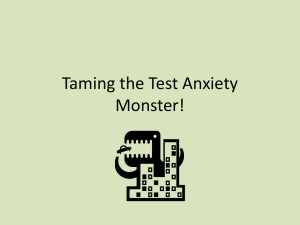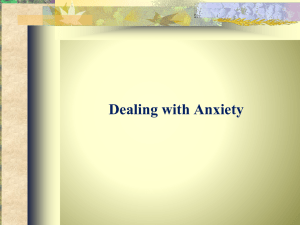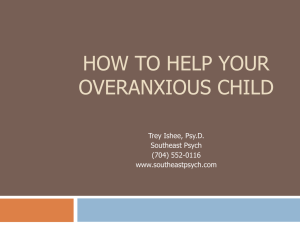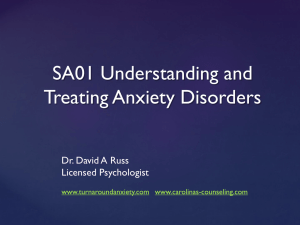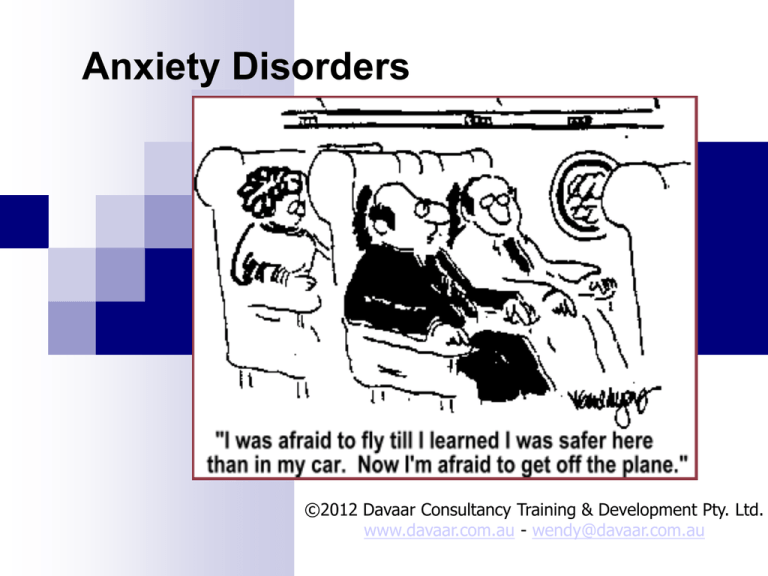
Anxiety Disorders
©2012 Davaar Consultancy Training & Development Pty. Ltd.
www.davaar.com.au - wendy@davaar.com.au
1 CNE point
Objectives
Understand anxiety
Discuss generalised anxiety disorder
Discuss panic attacks
Identify signs and symptoms of
generalised anxiety disorder
panic attacks
Discuss nursing interventions
Discuss management
“People are disturbed not by things, but
by the views they take of them”
- Epicetetus (Greek Philosopher)
Moreno (1972) understood anxiety as the
absence of spontaneity
Consider a time when have you felt anxious:
• crossing the road a car appears from nowhere
• sitting an exam
• attending a job interview
• being part of this group
What were the…
thoughts you had
(cognitions)
(e.g. “I am not safe”
Bio -physiological
Symptoms
(e.g Heart rate)
Emotional
Reactions
(e.g. fear)
Behavioral responses
(e.g. did not move)
Discuss in small groups
We all have our own coping mechanisms when we
feel under threat.
Who assess or judges that they are “dysfunctional / non coping?”
Anxiety disorders one of the most common
behavioural / mental health problems in childhood &
adolescence (Puskar, et al, 2009)
Between 8-12% of children experience some kind of
anxiety disorder (Bernstein, et al 1996; Muris & Steerneman, 2001)
13 out of every 100 children are affected by an
anxiety disorder
Anxiety disorders often occur with another mental
illness / physical illness
High correlation between substance use and anxiety
in adolescents (SAMHSA, 2007)
Famous People:
Abraham Lincon
Anthony Hopkins
Aretha Franklin
Eric Clapton
Sir Issac Newton
Sigmund Freud
Anxiety explained
•
most basic of all emotions
all people and animals experience anxiety
term anxiety used to describe all feelings &
symptoms that arise when an individual perceives
a threat or danger
anxiety is a natural, normal feeling that is necessary
for survival
differs in duration and in strength and varies from
mild uneasiness to extreme distress
is protective (while it can be unpleasant anxiety
cannot harm an individual)
Functions of Anxiety
first function of anxiety is to alert the individual threat
second function - to motivate the individual into
mobilising his/her defences ready for action
DSMIV: anxiety disorder – chronic
condition characterized by an excessive
and persistent sense of apprehension
Panic Attacks
Generalized Anxiety Disorder
Phobias (overwhelming sense of fear):
• Agoraphobia
P.T.S.D.
• Social Anxiety Disorder
Obsessive/Compulsive disorder
• Zoophobia
• Mysophobia
Separation
Anxiety
This session will address two
anxiety disorders:
Panic Attack
Generalised Anxiety
Disorder (GAD)
But first a review………….
An important point to remember whatever the
anxiety disorder …FLIGHT/FIGHT/FREEZE
response will be present:
this is a primitive mechanism that brings about
physical changes which are necessary in order
to prepare individuals to fight / run away /stay
still … this response controls anxiety whether it
is a mild or extreme response
when an individual perceives a threat the body
releases adrenalin to activate the autonomic
nervous system
Flight / Fight / Freeze Response
Useful - highly effective when our life is in danger and we
need tor respond… it motivates and protects us. It is
controlled automatically and we don’t have to think about it
Not useful when:
• it is set off in response to a perceived threat rather
than an actual one
• there is an impairment in thinking and problemsolving ability
• there is interference with sleep
• there is a disruption in memory and concentration
• the symptoms are unpleasant and prolonged and
when they interfere with one’s daily living
Perception of threat
Normal response
to threat
Limbic system
Amygdala Signals Alarm
Hypothalamus
Corticotropin-releasing factor
SNS
Pituitary gland
Adrenal Glands
Adrenocorticotropic hormone (CRF)
Epinephrine/Norepinepine
Prepare for fight/flight
Cortisol (Hydrocortizone)
Inhibits Alarm Reaction
Perception of threat
PTSD
Response
Limbic system
Amygdala Signals Alarm
Hypothalamus
Corticotropin-releasing factor
SNS
Adrenal Glands
Epinephrine/ Norepinepine
Prepare for flight/fight
Pituitary gland
Adrenocorticotropic hormone (CRF)
Cortisol (Hydrocortizone)
Mobilization Persists
PTSD symptoms
Not able to halt
alarm reaction
Generalised Anxiety Disorder
• Approx 5% Australian population experience GAD
(beyondblue)
• free floating anxiety accompanied by autonomic
symptoms such as tremor in hands (Moore, 2008)
• onset is gradual and may initially occur in teenage
or early adult years
• chronic pervasive sense of anxious apprehension &
tension
• individuals with GAD often worry every day about
• routine life circumstances i.e. job responsibilities,
• financial situation, health of family members,
household chores, care repairs, being late for
appointments
• anxiety / worry is associated with three or more of the following:
being easily fatigued
irritability
muscle tension
• difficulty concentrating or mind going blank
• sleep disturbance (difficulty falling or staying asleep, or restless
unsatisfying sleep)
• the anxiety/worry/physical symptoms are not due to direct
• physiological effects (medications), medical condition
(hyperthyroidism) and does not exclusively occur during
• a psychotic episode, mood disorder
• the anxiety/worry/physical symptoms cause clinically significant
distress or impairment in social, occupational or other important
areas of functioning (Antai-Otong, 2003; Kettler, et al, 2005)
Essential features:
•“excessive anxiety and worry (apprehensive
expectation), occurring more days than not”
•difficult to control the worry
Physical symptoms
feeling cold, clammy hands, dry mouth,
sweating, nausea, or diarrhoea, urinary
frequency, trouble swallowing “lump in throat”,
easily startled
In clinical settings GAD is diagnosed
more frequently in women than in men
Why might this be the case?
Panic Attack
•
•
•
•
•
•
•
often accompanied by a sense of imminent
danger or impending doom
palpitations, pounding heart, or accelerated
heart beat, sweating, trembling/shaking
sensations of shortness of breath or
smothering
feeling of choking
chest pain/discomfort
nausea/abdominal distress
feeling dizzy, unsteady, light headed or faint
•
•
•
•
•
derealisation or depersonalization
fear of losing control or going crazy
feat of dying
paresthesias (numbing/tingling sensations)
chills or hot flushes
Individuals seeking care for unexpected panic
attacks will describe the fear as intense, &
state that they “thought they were going to
die”, “having a heart attack” “going crazy” and
report experiencing an urgent desire to flee
• Approx 3 out of 10 people in Australia will
experience at least one panic attack in their
lifetime
• Approx 3% of population have a panic attack
disorder
Causes
•
•
•
•
Multifaceted neurobiological
neurotransmitter involvement –
norepinephrine, serotonin, GABA
atrophy to both amygdala (Massana et al, 2003b)
Hereditary
Psychosocial (Role modelling)
Environmental
Strategies…..
Nursing in the moment:
• stay calm, regulate own breathing
• whatever the wish… resist the temptation to
abandon the client
• work with the client to regulate their breathing
(may have to demonstrate)
• talk in a calm, firm and reassuring tone
• (the client needs to be able to hear you and
needs to have a sense that you know what you
are doing and that you can contain their
overwhelming fear/ terror)
Longer term...
• work with client to recognise their own
strengths and resilience
• facilitate their self appreciation (they got this
far, what enabled that?)
• be clear about your boundary issues in terms
of the clients capabilities
• work with the client to develop a hierarchy of
symptoms and interventions
Interventions / Treatments
Solution Focused Approach
Cognitive Behavioural Therapy
Stop, Think, Go
Group Therapy
Relaxation / meditation
Counselling (narrative, gestalt, client centred)
Medications
Antidepressants - SSRI’s, Tricyclics, MAOI’s
Benzodiazepines - Diazepam
Inositol – naturally occurring isomer of glucose,
participates in the action of serotonin
What other interventions
can you identify to:
• assist decrease the symptoms of anxiety?
• manage long term anxiety?
Discuss in small groups
Questions?
References
Antai-Otong, D. (2003). Current treatment of Generalized Anxiety Disorder.
Journal of psychosocial nursing, 41 (12), 20-29
Bernstein, G., Borchardt, C., & Perwien, A. (1996). Anxiety disorders in
children and adolescents: A review of the past ten years. Journal of the
American Academy of Child and Adolescent Psychiatry, 35 (9), 1110-1119.
Frances,A., Pincus, H.A, & First, M.B. (1994). Diagnostic & Statistical
Manual of Mental Disorders 4rth Edition. American Psychiatric Association:
Washington 393-444
Kessler, R.C., Chiu, W.T., Demler, O., & Walters, E.E., (2005). Prevalence,
severity and comorbidity of twelve-month DSMIV disorders in the National
Co morbidity Survey Replication (NCS-R). Archives of General Psychiatry
62 (6), 617-27.
Moore, D. P. (2008). Textbook of clinical neuropsychiatry (2nd edition).
Hodder Arnold: London.
Muris, P., & Steerman, P. (2001). The revised version of the screen for child
anxiety, related emotional disroders (SCARED-R): First evidence for its
reliability and validity in a clinical sample. British Journal of Clinical
Psychology, 40, 35-44
Puskar, K., Berndao, L.M., Ren, D., Stark, K.M., & Lester, S. (2009). Sex
differences in self-reported anxiety in rural adolescents. International
Journal of Mental Health Nursing, 18, 417-423.
Substance Abuse and Mental Health Service Administration (SAMHSA).
(2007). Children’s mental health facts: Children and adolescents with
anxiety disorders. (Cited 10.12.2009) Available from:
http://mentalhealth.samhsa.gov/publications/allpubs?CA-0007/defaultasp






